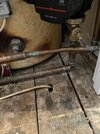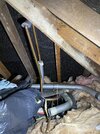Thats strange re noise since your present head is 4.2M so the head should have been lower with decreaed noise levels on CP1 (3M) and PP2 (3.7M, max), PP2, even though probably a bit weak at ~ 2.5M at say 0.9ms/hr may be worth another go?.
View attachment 289397
Apologies John, I meant the CC speeds, CC2/3 gave more noise than CC1. Yet to try the other speeds which I’m doing today. Last few days have been a crash course in plumbing terminology, does a lower head essentially mean the pump will run at a lower speed?





